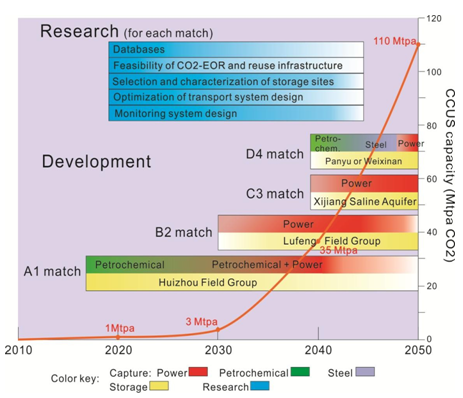|
|
D02 - Offshore CO2 Transportand Storage Options for a Deep Cut of GHG Emissions in Guangdong发表时间:2018-09-06 17:03 The ARP2 report for the ADB CCS Center for
Offshore CO2 Transportand Storage Options for a Deep Cut
Di Zhou1,2, Pengchun Li1,2, XiLiang1,3, Li Wang1, Muxin Liu1 1UK-China(Guangdong) CCUS Centre, Guangzhou, China 2South China SeaInstitute of Oceanology, Chinese Academy of Sciences 3Business School,University of Edinburgh
Summary for Policy Makers There are a series of LPSs of CO2 emissionsin Guangdong province which could be stored in depleted oil and gas fields anddeep saline formations in two offshore basins, the Pearl River Mouth Basin(PRMB) and the Beibuwan Basin (BBWBB) in the northern South China Sea. There ispotential, at least in the initial stages of this plan, to use CO2-EORwhich implies utilization as well as storage. A development plan of offshore CO2 storageand transport in the northern SouthChinaSea for Guangdong in 2030 and 2050 is proposed in this report, as one of thedeliverablesof the ADB funded RDTA8714 project (2016-2017). The principles of our planning are being ambitious and achievable in accordance with the demand and ability of Guangdong, and tominimize the total CCUS cost. Then we adopted a two- phase and dual-trackapproach, which consists of a low-cost CCUS Phase I and a cost-competitive CCUS phase II, with a track of projectsand a track of researches in each phases. To reduce the total cost, thecluster-hub model of sources and sinks is adopted in the planning, and reuse ofexisting infrastructures is preferred. The targets of CCUS development in Guangdong by 2050 proposed in this reportare about 8% of the CCS targets in China proposed in the roadmappublished by ADB (2015). Only the projected CO2 avoidance in 2050was reduced to ~4.6% of China, which is ~32% of the total LPSs CO2 emission inGuangdong in 2050, taken into consideration of the cost-effectiveness of theCCUS chain. The proposed plan on offshore CO2 storage andtransport for Guangdong in 2030 and 2050 is schematically generalized in Figure below.
The low-cost CCUS Phase I before 2030 is characterizedby the CO2 capture mainly from the petrochemical industry and CO2storage mainly related to CO2-EOR. The target of CCUS in this phaseis ~1 Mtpa in 2020 and ~3 Mtpa in 2030. These will lead to the cumulativeCO2avoidance of ~1 MtCO2 by 2020 and~12 MtCO2 for 2020-2030.This will be accomplished by the source-sink match A1, which consists of the CO2captured from the Huizhou area of the Pearl River Delta with Hub A, the storagein one or two oil fields in the Pearl River Mouth Basin with Hub 1 at theHZ21-1 field, and a stem pipeline connecting hubs A and 1. The Phase II from 2030 to 2050 is characterized by awider deployment of cost-competitive CCUS. The target of CCUS in Guangdong is~35 Mtpa in 2040 and ~110 Mtpa in 2050, leading to the cumulativeCO2avoidance of ~187 MtCO2for 2031-2040 and ~730 MtCO2for 2041- 2050. Researches are essential to accompanying the developmentphases. Databases need to be built on the large point sources of CO2 emission, on the potential storage sites, and on existing infrastructures inthe potential sites. Feasibility of CO2-EOR and reuse existing infrastructureneeds to beevaluated. The storage sites need to be selected and characterized. Theoffshore transport and injection system need to be optimized in the front endengineering design. The cost need to be estimated. The monitoring, reporting,and verification system need to be built. These researches must be conductedwith enough lead time, so that the research results can guide and support thefulfillment of the CCUS development targets in each phase. As the years of 2030 and 2050 are too far and too ununcertain, and this report was written based on published data only, we arefully aware that the planning presented in this report is rather general andhypothetic. The plan need to be revised over the entire course of CCUSdevelopment in terms of feasibility, cost effectiveness, andsocio-environmental impacts based on improved understandings and new findingsfrom research and development. |


